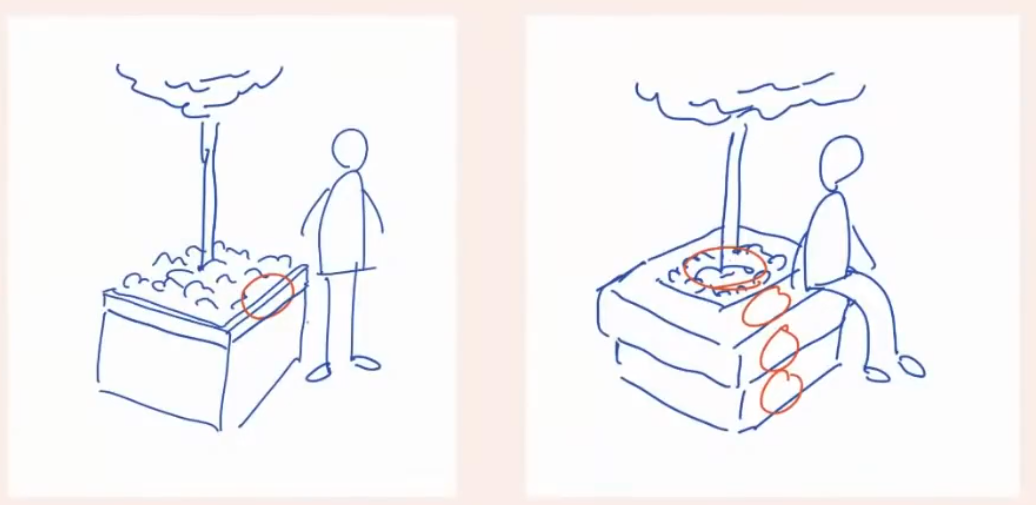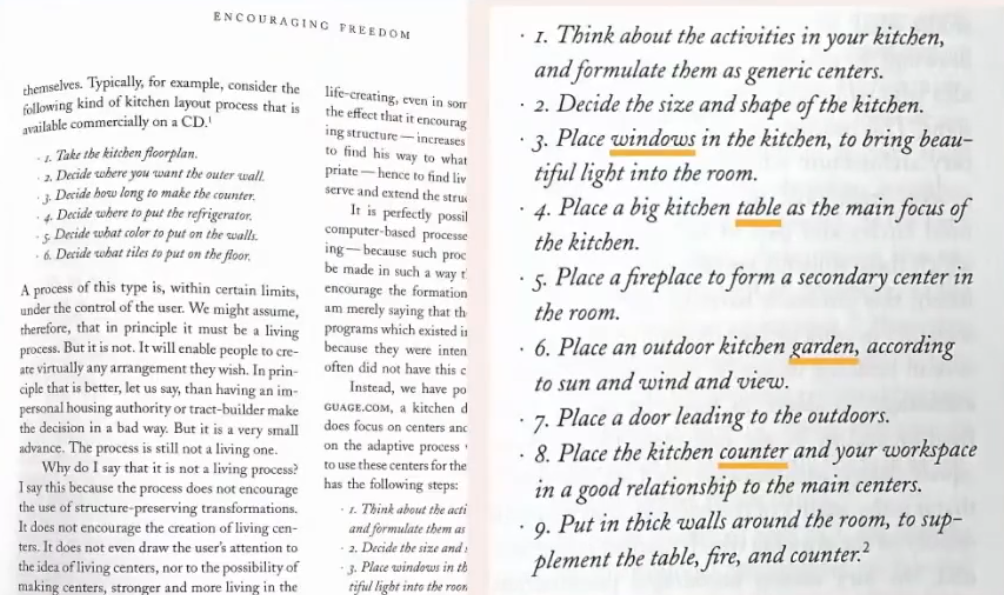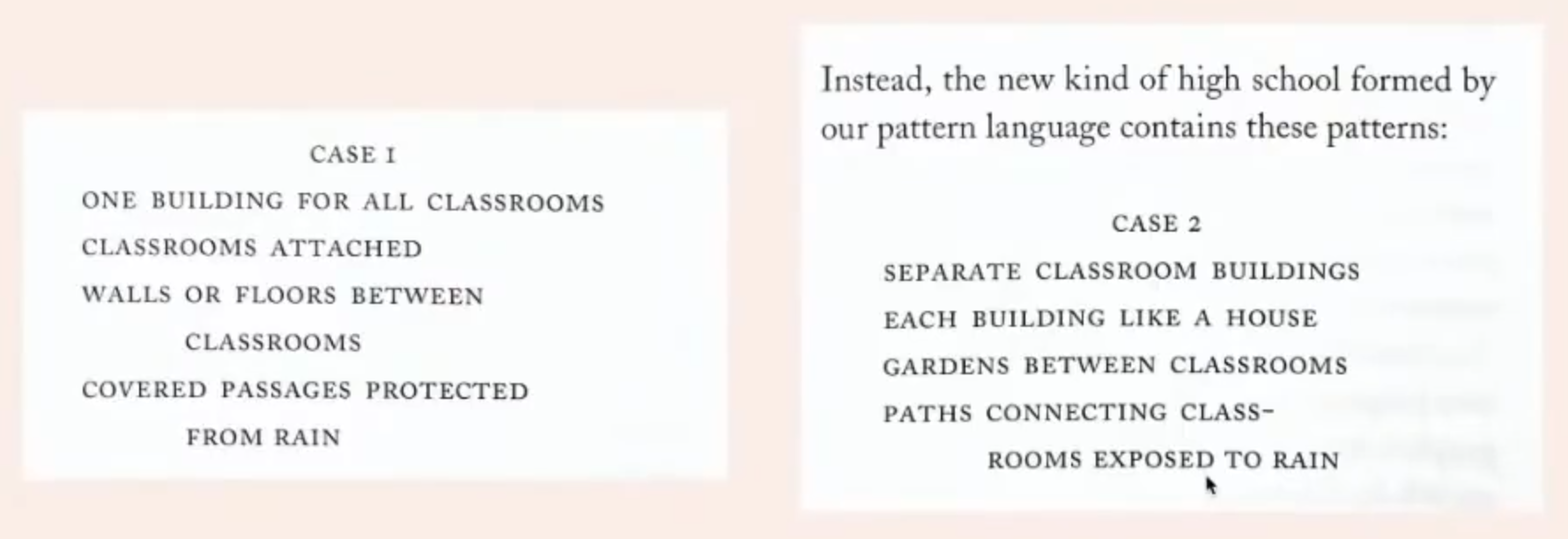Once you've worked with love, you won't want to work in any other way.
This is a fundamental view of the world. It says that when you build a thing you cannot merely build that thing in isolation, but must also repair the world around it, and within it, so that the larger world at that one place becomes more coherent, and more whole, and the thing which you make takes its place in the web of nature, as you make it.
I first feel existence shimmering in reality, and I then feel it deep enough in the thing I am looking at and trying to make, to know it is worth capturing in concrete and wood and tile and paint. … This thing, this something, is not God, it is not nature, it is not feeling. It is some ultimate, beyond experience. When I reach for it, I try to find— I can partly feel— the illumination of existence, a glimpse of that ultimate. It is always the same thing at root. Yet, of course, it takes an infinite variety of different forms.
This is what I have felt on the beach on the north shore of Point Reyes, near San Francisco, when the sea comes crashing in with enormous force, when the water and wind are too loud for me to hear my voice, the waves too strong for me to think of swimming, the force of the water and the wind, the white foam of the waves, the blackish green moving water, the huge, loud grinding swells, the beach sand that goes on forever, the seaweeds strewn on the beach that have been hurled by a force greater than they are— as I am, also, when I walk among them. Yet, even though I am next to nothing in the presence of all this forces, I am free there. In such a place, at such a moment, I am crushed to understand my own smallness, and then understand the immensity of what exists. But this immensity of what exists— and my connection to it— is not only something in my heart. It is a vastness which is outside me and beyond me and inside of me.
A pattern language is what we create for a project to specify this project at the right level of abstraction. It gives us a stepwise path through the problem-solving process, so that we can, step-by-step, adapt each center to the neighboring centers, and weave them into a field of centers which are all working together. It allows us to avoid overspecifying all the details that we don't understand in the beginning. – Ryan Singer interpreting Christopher Alexander
- person Christopher Alexander
- https://en.wikipedia.org/wiki/Christopher_Alexander
- https://www.buildingbeauty.org/alexander
further reading (world building from a practical persepctive)
- Nikos Salingaros
- Daniel Christian Wahl
- mang, Haggard
- Arne Naess
books
- Notes on the Synthesis of Form
- The Nature of Order, Book 1
- The Nature of Order, Book 2
- The Process of Creating Life: Nature of Order, Book 2: An Essay on the Art of Building and the Nature of the Universe
- The Battle for the Life and Beauty of the Earth
related books
Design for a Living Planet: Settlement, Science, and the Human Future
Regenerative Development and Design: A Framework for Evolving Sustainability
The Ecology of Wisdom: Writings by Arne Naess
Randolph Hester Design for Ecological Democracy (recommended from bonnitta-roy)
Coyote's Guide to Connecting with Nature Young, Has, McGown (recommended from bonnitta-roy)
Sounds good for nieces and nephews
Died 2022.03.17
Lookup
- Thought Leaders Christopher Alexander
- UGLINESS IS A DISEASE: How Ugly Architecture & Environments Harm Us - YouTube
- Contrasting Concepts of Harmony in Architecture
- The Application of Feeling -- Christopher Alexander
- At Any Given Moment in a Process tags.to-read
- Christopher Alexander: Generating a Living World (pt1)
- Christopher Alexander
- Christopher Alexander - Patterns in Architecture
- Dorian Taylor on Christopher Alexander
- “How do you compress the entire life's work of this guy down to something that an ordinary person is not going to misunderstand?”
- A City is not a Tree
Alexander on Patterns
Framing, from intro: The Timeless Way of Building says that every society which is alive and whole, will have its own unique distinct pattern language; and further, that every individual in such a society will have a unique language, shared in part...in a healthy society there will be as many pattern languages as there are people... we have written this book as a first step in the society-wide process by which people will gradually become conscious of their own pattern languages, and work to improve them... We have spent years trying to formulate this language, in the hope that when a person uses it, he will be so impressed by its power, and so joyful in its use, that he will understand again, what it means to have a living language of this kind. And yet we do believe, of course, that this language which is printed here is something more than a manual, or a teacher, or aversion of a possible pattern language. Many of the patterns here are archetypal... it seems likely that they will be part of a human nature...We doubt very much whether anyone could construct a valid pattern language, in his own mind, which did not include the pattern Arcades (119) for example, or the pattern Alcoves (179)... This sequence of patterns is also the "base map", from which you can make a language for your own project, by choosing the patterns which are most useful to you. Well that's incoherent...
http://webseitz.fluxent.com/wiki/AlexanderPatterns
from Christopher Alexander: A Primer
- intro
- what is a productive way to frame a design problem?
- what is the actual outcome we trying to reach by solving the design problem?
- form follows function -> form follows meaning
- abstract <-> concret
- heaven <-> earth
- concepts
- form a. the thing we are going to make or modify b. the way we are going to get a good form is to understand how it fits into context c. 15 kind of relationships that define a form
- context a. refers of the dynamics of the system
- fit a. has to happen at the concret level i. At the abstract level there are not tradeoffs
- how to apply the 3 concepts
- we need to understand why we are doing things
- it is not necessarily a knowing.4-p#propositional understanding!
- the success if the fitness/relationship of these things
- needs to have a meaning concepts.fitness-function
- what if the definition of success was a struggle, something that someonw was trying to do but not able to do. i. describing it in a form agnostic way ii. chapter "goodness of fit"
- we need to understand why we are doing things
- Beyond Fitness: Life and a better world
- quality-without-a-name
- he started to name it with many different examples
- Soviet style vs living courtyard building
- the question is what type of action can take place in these buildings
- are these buildings adaptable to change of context and relationship
- do they have antifragility
- What are the affordance of the design?
- Soviet style vs living courtyard building
- the name he have it was "life"
- a form that enables different activites to take place
- is this what i refer to finding a fitting metaphor for a struggle/problem from which to think about it. A kind of knowing.4-p#perspectival ?
- observations
- eye movements
- lighten up the brain
- eye movements
- examples

- he started to name it with many different examples
- quality-without-a-name
- tool
- Centers — Coherent regions in spatial structure
- static
- things have a relationship with oneanother
- these relationships have a kind of coherence or lack of coherence(incoherent)
- A center is a way of describing those elements in these fields of related elements that are more coherent/salient and related to eachother.
- is this pointing to john-vervaeke relevance-realization?
- Zoomin in on this salient thing and contemplating on how to better it.
- Nature does this, the nitting and creating centers together
- We don't get it for free
- Organic
- Just having coherent centers does not mean that the designed centers "talk" with each other.
- Do the things/centers related with each other.
- Strong/Weak centers
- Every structure has salient parts that are coherent or less coherent
- We improve coherence by bettering the centers and by relating them
- mirror-of-the-self-test
- Process — Step by step adaptation
- dynamic
- how to overcome complexity
- step by step unfolding/adaptation
- work of right-hemisphere
- sequence/order is very important
- there is a path dependence
- the thing we do first constrain what we do next and do next ad infinitum.
- this can get us either to a good result or pain us into a corner
- with the right sequence things/centers talk/relate to each other. the wrong sequence misses relations
- eg if you design the garden before the house the house will related to the garden and the garden to the broader environment. The inverse is not true because than you would design the garden based on the structure of the house and that constrains on the design of the garden will not allow it to relate to the broader environment.
- Centers — Coherent regions in spatial structure
- 15-properties-of-wholeness
- Project-Specific pattern-language
- How to use a pattern language to get to unfolding something
- A pattern is a kind of generic relationship of centers.
- Center -> Structure -> Form
- Pattern is a bundle of: Form & Context
- How does this relate to compositionality
- example
- min. 6 foot dept balcony for it to be functional for use

- min. 6 foot dept balcony for it to be functional for use
- A pattern is a kind of generic relationship of centers.
- Pattern languages maybe useful in terms of helping us to communicate solved problems and to pass on knowledge that is more or less modular.
- So that you don't waste time reinventing the wheel.
- This is not the deeper meaning of patter. This is an efficiency game.
- So yes this is useful but not the main thing.
- The main thing is that the pattern languge is a way to specify one unique project.
- To do one thing right.
- A pattern language is actually what we create for a project wo specify this project at the right level of abstraction.
- Step wise path to the problem solving process. So that we can adapt each centers to the neighboring center and bring together into a harmonies field of centers which are all working together
- It allows us to avoid overspecifying all the details that we don't understand at the beginning. a. We cannot in one flash draw a master plan that says: here is the design. If you do, you will discover that is does not fit with reality. This is because we do not have all the interactions of components in our heads. The truths of the fields of relationships between of all the ui.components wether its the spacial relationships of a garden the house and the neighboring parts or the interdependence of code in software
- What you want is higher level way of parts and allow the once that do the construction to go into the level of detail, figuring out the actuall final form in the context of doing the building.
- This allows us to unify construction and design at the right level of scale
- examples

- each case is a pattern language containing patterns.
- each case generates different buildings
- because it specifies the design of the right level of abstraction many different ideas can appear.
- inner precinct
- form language vs pattern language
- this about domain dependent vs domain independent pattern
- demain independent patterns have form patterns the are general valid.
- It is more a stylistic language gestalt
- this about domain dependent vs domain independent pattern
- How to use a pattern language to get to unfolding something
- Takeaway for people who design systems
- frame the design problem in terms of form and context
- form as the thing we are making
- context is what are the types of activities and the contrains based on the dynamics of the situation so we have an actual and emperical judgement of fit
- and further its about what that fittedness of form an context enables as kind of meaning activities to take place.
- not just doing what to client ask for but making a kind of whole structure that enables more meaningul things to happen bases on that structure.
- To characterize that structure:
- In terms of centers. Having that level to characterize a coherent structure.
- That coherent structure emerges by a step by step unfolding where we specify the key relationships and the sequence of problem solving those relationships at the right level of generality using a pattern language.
- The pattern language is not a static thing but something that describes the problems and they key relationships for the one project we are trying to build.
- By specifying at the right level of abstraction we create the freedom at the low level to do step by step adaptation between the parts.
- Generative design process
- frame the design problem in terms of form and context
- questions
- books mentioned:
- Notes on the Synthesis of Form
- The Nature of Order, Book 1
- The Nature of Order, Book 2
- The Battle for the Life and Beauty of the Earth
- other links